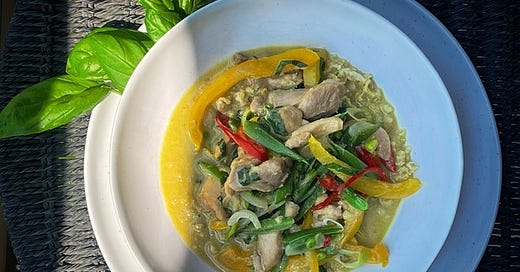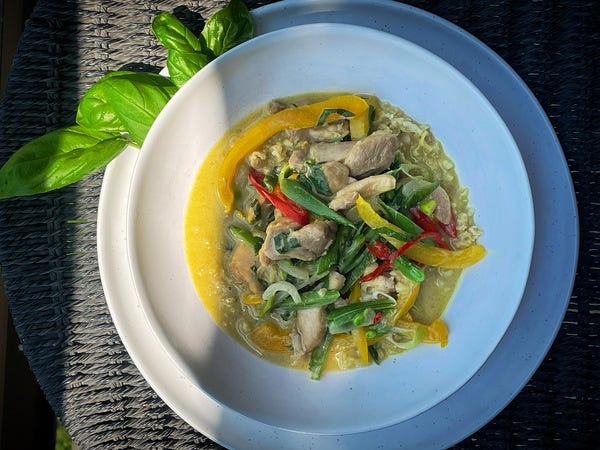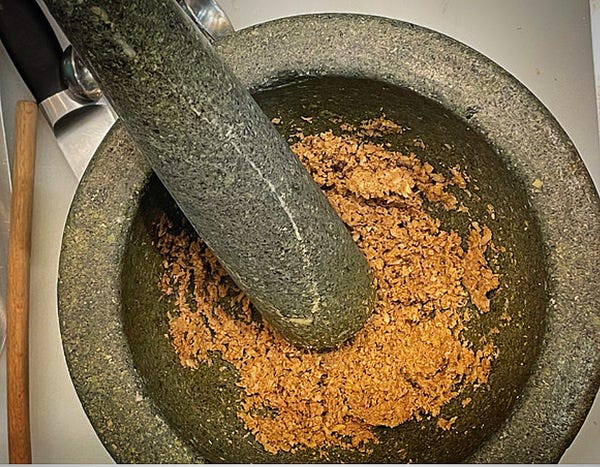Well, friends, the heat is on in Toronto, as promised.
You’ll remember last week, when I was sniveling about the unseasonable cold (it’s linked at the bottom of this post if you missed it) I mentioned I lean into Indian flavours in the chilly months. The warming spices and rich sauces help calm my chattering teeth.
Now that temperatures have been righted, and the deep heat of summer is setting in, my cravings turn to the bright and bold flavours of Thailand and Vietnam.
And today’s dinner party suggestion is a red-hot doozy.
Upon my sister’s urging, I took a Thai cooking course last year. Up until that point, I liked Thai food well enough, but my knowledge was pretty pedestrian, mostly consisting of green curry and pad Thai. I certainly couldn’t tell you the difference between Naam Prink Ong and Khanom Juan Naam Ngiaw (the former is pork and tomato dip, the latter, curry paste, if you find yourself in the same boat.)
Like most things in life — at least in mine — what started as neutral interest, ended in enthusiastic absorption. A gigantic pestle and mortar now lives on my countertop. My pantry and freezer are overflowing with lemon grass, cilantro root, shrimp paste, rice noodles, and palm sugar (and many more items, but you catch my drift.)
Even though we are officially in a heat wave in Toronto, the high temperatures are still novel and glorious; we’re not yet at the oppressive point of, don’t turn on the stove recipes (give me a few weeks.)
However, what’s very handy about this one is the curry paste, should you endeavour to make your own, is it can be kept safely in the fridge for weeks, and frozen indefinitely. Similarly, once the whole curry is already made, leftovers can be frozen for a few months without too much sacrifice. So this recipe is a terrific contender to make during the cool(er) mornings and save for a sweltering day. Your guests will marvel at your dedication. No need to tell them the truth.
Serve this on rice and complete the menu with a few salads – I like to pair spicy cucumber (just cucs, red chili pepper, and shallots in a sharp and sweet dressing of white vinegar, sugar and salt), and a watermelon feta for a super refreshing and deeply flavourful meal.
Before we carry on, I want to make a quick note about the authenticity of this recipe – which is to say, it is. Mostly. It was taught by my instructor, Nantana, who moved to Canada in 2015 and now runs a Thai restaurant in Toronto and teaches Thai cooking at George Brown College, the hospitality school where I also work (teaching wine.)
However, as I wrote in this piece on Thai coconut shrimp, authenticity can get a bit tricky when it comes to personal taste and even ingredient availability. There were many times in class where Nantana mentioned we didn’t have the “right” ingredient, so something else would have to work in its place.
In Nantana’s recipe, the curry only includes pea eggplant and round eggplant as the vegetables. I couldn’t find them, nor did I look very hard, because I don’t like them. Instead, I added in sugar snap peas, bell pepper, and onion. I also prefer a saucier curry broth, which Nantana says is not how it’s done in Thailand.
I constantly fret over giving too much information in a recipe or lengthening the leash a bit to allow the home cook the freedom to explore and create and adapt to their own needs. Ultimately, I think I’ve fallen on giving as complete instructions as I can, while also having faith cooks will take it upon themselves to do what they need to make a recipe work for them.
Also, do let me know: do you prefer recipes written into the body of this post, or the downloadable pdfs?
Thai Green Curry Chicken
Makes: about 5 portions
Chef Level: moderate
Ingredients:
3 Tbsp neutral oil, such as vegetable
3 Tbsp green curry paste (see note, below)
2 lbs chicken thighs cut into strips
400ml coconut milk
1 puck palm sugar OR 2 Tbsp brown sugar
2 Tbsp fish sauce
1 medium onion sliced
1 yellow pepper, sliced into strips
1 cup sugar snap peas, strings removed and sliced on the bias
1 red hot chili pepper, sliced on the bias
½ cup fresh basil leaves, cut into ribbons (chiffonade)
10g dried whole lime leaves (these are used for flavour infusion, you don’t eat them)
How to Make It:
In a wok or high sided pan, heat the oil over medium-low. Add the curry paste and stir-fry for about two minutes, until shiny and fragrant.
Add the chicken and stir fry for about 2 minutes until ¾ cooked.
Pour in the coconut milk, enough to cover the chicken, and increase the heat to bring to a boil.
Turn the heat back down to medium-low, add the fish sauce and sugar and stir through.
Add the vegetables, cover the pan and cook for about 5 minutes until the vegetables are softened.
Stir through the basil and lime leaves and serve over rice.
Green Curry Paste
This is a project. A very worthwhile one, that will yield eye-rolling, why-haven’t-I-done-this-before results, but it’s a project, nonetheless.
This recipe does call for a mortar and pestle. But if push comes to shove, you can chuck it all in a food processor and be done with it. You will get good results – not as fantastic as making by hand, but the same difference as that of a pesto in a food processor and that of a pesto made by being bashed-about.
Pummeled in a mortar in pestle for easily 45-minutes (Nantana told the class she puts on a movie while doing it, as much for entertainment as for taking her mind off the monotony of it all), it will be your arm workout for the week. Maybe the month.
But for those willing to take up the challenge, know that fortune favours the brave and the results are truly worth it. (And you will be absolutely euphoric over your stunning triceps.)
Keep bashing until you have a smooth paste without any discernible lumps. You want the consistency and moisture level of fresh brown sugar.
(And yes, if all this seems a bridge too far, you can certainly skip the work and buy green curry paste – ideally from a good Thai restaurant or Asian grocery store, but the commercial supermarket versions work fine, too. It will not yield the transportive, mind-altering results of homemade, but will do in a pinch. Seriously, don’t sweat it. Life’s short and you need to pick your battles.)
Wine Pairing
There’s always a few options for food and wine pairing. If there is an occasion where only one thing will work, I can’t think of one. So this is license to play with you food and have some fun (if you even needed permission to do so).
Green curry is rich and creamy with the coconut milk, and sweetly herbal with the fresh basil, and cilantro and lemon grass-based paste. These are the flavours and texture we want to focus on for a good wine pairing.
I really like fruity, dry rosé with green curry. The umami-salty edge to the sauce brings out the berry flavours in the wine, and the crisp acidity of the rosé cuts through the coconut milk.
You could also match the herbal notes of the dish with an equally green and fresh Sauvignon Blanc. And the zippy character of the wine will work just like the rosé does to mop up some of the fattiness of the creamy sauce.
Finally, if you would like to match weight, a Chenin Blanc from South Africa or Pinot Gris from New Zealand both have the silky texture to stand up to the curry, and the tropical fruit notes to compliment the sauce.
Thank you for reading Quaintrelle!
If you enjoyed this post it would mean so much to me if you could share this post with friends who love to eat, drink, and generally try to enjoy themselves.
And, if you want to throw a little love my way, checking that heart down below signals to the powers that be people are reading this, and please don’t bury me in the algorithm avalanche.
As always, I am so grateful for your time and attention.
xo -Erin
What to Eat on Chilly Summer Nights
It’s been unseasonably cold this past week in Toronto. To wit: I’m inside, wearing jeans and a light sweater, as I write this. Yesterday I wore a scarf. And not wrapped around my head as I rode in a convertible along the Lakeshore. Around my neck. For warmth. In June.













Stay cool out there, Erin! This dish looks absolutely mouthwatering. (FWIW, I loved the line "I couldn’t find them, nor did I look very hard, because I don’t like them." 😅 Relatable!!)
Love the variety of wine pairing options! I usually go the Sauvignon Blanc route with green curry, so I'll have to pull out a favorite rosé next time.